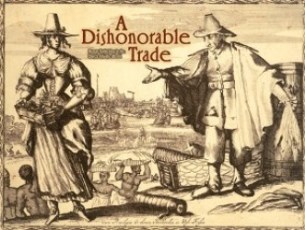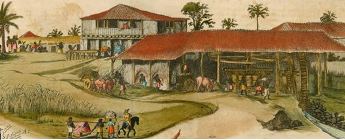Crailo State Historic Site

9 1/2 Riverside Avenue
Rensselaer, NY 12144
- General Information: (518) 463-8738

Crailo was built in the early 18th century by Hendrick Van Rensselaer, grandson of the First Patroon. Hendrick died in 1740 and his eldest son, Johannes, inherited Crailo. He remodeled the house and added an east wing in the Georgian style, reflecting the increasing influence of the English on the Albany-area Dutch. In the late 18th century, Crailo was remodeled in the Federal style. It served as a boys' boarding school in the 1840s and later as a church rectory. Each new venture brought more changes to the structure. In 1924 Crailo was donated to New York State for development as a museum. Crailo today tells the story of the early Dutch inhabitants of the upper Hudson Valley through exhibits highlighting archeological finds from the Albany Fort Orange excavations, special programs, and guided tours of the museum.
Outreach programs to schools and hearthside cooking programs are available by reservation.
Congratulations Crailo, WINNER of the 2010 CINE Special Jury Award for the film: "Keeping Order: A Fort Orange Court Record"
Hours of Operation
- Hours of Operation
2025 SeasonCrailo opens for the season on Wednesday, May 15 and runs through October 31, 2025.Days open: Wednesday – Sunday, Hours: 11:00 a.m. to 5:00 p.m.In general, guided tours of the museum begin at 11:00 a.m. and are offered on the hour, with the last tour at 4:00 p.m.Please note: Pre-registered group and special events may alter tour schedules, so calling the site prior to your visit in recommended!Crailo grounds and riverside park are free and open to the public, dawn through dusk.
Fees & Rates
Most New York State Parks charge a vehicle use fee to enter the facility.
Fees vary by location and season. A list of entry fees and other park use fees
is available below. For fees not listed or to verify information, please
contact the park directly.
- Tours Admission
- Adults
/ $5.00Seniors & Students / $4.00Children (12 & under) / Free
- SCHOOL GROUPS (ON-SITE) / K – 12th Grade
- Fee
per student: $1.00 (Please note: there is a minimum fee of $20 per group)Teacher & Required chaperones: FreeChaperones: 2 Chaperones for every 10 students requiredExtra adults (beyond required # chaps): $4.00 per personHearth Cooking Program added to tour: Fee is an additional $3.00 per student. Please note: the max amount of students for Hearth Cooking is 20
- OTHER GROUPS (ON-SITE)
- K—12 Groups (Scouts, Camp, etc)Fee per child: $1.00 (Please note: there is a minimum fee of $20 per group)Group leader / Guide / Required chaperones: FreeChaperones: 2 chaperones for every 10 kids requiredExtra adults (beyond required #): $4.00 per personMaximum # people per each Crailo guide: 12Hearth Cooking Program added to tour: Fee is an additional $3.00 per person. Please note: the max amount of participants for Hearth Cooking is 20
- Other Groups
- (Any group outside K – 12) older Youth Groups, College- Age Groups, Seniors, Organizations, Etc.Fee per person: $4.00 (Please note: there is a minimum fee of $20 per group)Group leader / Guide: FreeMaximum # people per each Crailo guide: 12Maximum amount people in house museum: 56 (busload)Hearth Cooking Program added to tour: Fee is an additional $3.00 per person. Please note: the max amount of participants for Hearth Cooking is 20
- Special Needs Group
- PARKS GROUP ACCESS PASS is available! For more information and application, please visit:Fee per person without Group Access Pass(including chaperones): $1.00Maximum # people per each Crailo guide: 12
- OUTREACH (OFF-SITE)
- Schools (K– 12)Fee per student: $1.00Minimum fee for presentation: $30.00For schools, generally 1 classroom = 1 presentationCombining classrooms not permitted (please ask)Other Groups (other than K-12 or Schools):Fee per presentation: $30.00All outreach programs limited to a 30 minute drive from Crailo SHS **
Tours 2025 Season
Crailo opens for the season on Wednesday, May 14 and runs through October 31, 2025. Open days: Wednesday – Sunday / Hours: 11:00 a.m. to 5:00 p.m.
In general, guided tours of the museum begin at 11:00 a.m. and are offered on the hour, with the last tour beginning at 4:00 p.m.
The tour also includes stairs: for complete accessibility information, please click on the Know Before You Go link on Crailo's main page.
Please note: Pre-registered groups and special events may alter tour schedules, so calling the site prior to your visit is recommended!
Crailo grounds and riverside park are free and open to the public, dawn through dusk.

A Dishonorable Trade: Human Trafficking in the Dutch Atlantic World
Photo Credit: Detail of a 17th century Dutch Colonial Map
Sugar Works and Plantation, Pernabuco, Brazil
John Bleau c.1640
Courtesy of the John Carter Brown Library, Brown University
This temporary exhibit on the Dutch slave trade in the seventeenth century highlights both the Dutch trade network in the Atlantic and the effect this commercial enterprise had on the lives of Africans who became forced laborers in foreign lands. One section (and exhibitspace) of the exhibit is devoted to the trade, while a second section and space) centers upon the people who were enslaved.
The exhibit explores the interconnectedness of the African, Caribbean, South American, North American and European trade networks of the Dutch West India Company and highlights the activity between Curacao and New Netherland. New Amsterdam and the van Rensselaer family are also included, which serves to highlight regional participation in the larger, worldwide system.
Research and the development of the exhibit was spearheaded by both an important grant from the Gilder Lehrman Center for the Study of Slavery, Abolition and Resistance and an immersive study session at the Yale Public History Institute of Yale University during the summer of 2013. Three Crailo staff members worked with Yale History professors, Gilder Lehrman Center staff, the American History Workshop staff, The Smithsonian Museum of African American History and Culture staff, and experts in the interpretation of the history of slavery and civil rights.
Other contributors and facilitators included artists, curators and educators from national art museums, who proposed creative approaches with which to interpret the history of people whose own words and objects are often missing from the historical record, and two Yale University graduate students who's invaluable research assistance contributed immeasurably to the exhibit's content. We remain grateful for the opportunity to have worked with these talented people and for their contributions to both the exhibit and the subsequent interpretation we use at the museum to engage people in this important and expanding field of history.
The exhibit A Dishonorable Trade: Human Trafficking in the Dutch Atlantic World was displayed at Crailo State Historic Site from 2015 to 2018, after which it traveled and was exhibited at other venues, including the Empire State Plaza. It has now returned to Crailo and will be on exhibit through mid-November 2024.
Crailo Wins 2010 CINE Eagle Award & Special Jury Prize!
An idea generated by the staff at Crailo State Historic Site—to combine a 350 year old local court record and Dutch genre painting and bring them to life--has been recognized by the National CINE Film Awards! In early 2009, Argentine Productions was chosen to produce the 2 - 3 minute film for Crailo's 2009 permanent installation, A Sweet and Alien Land: Colony of the Dutch in the Hudson River Valley. The production, which took place near Pittsburgh, Pa. in a very cold studio, included two Dutch Americans, actors from local colleges, and a couple volunteers. Site staff were on hand to advise on 17th century Dutch mannerisms and costuming. While there were many tricky obstacles to overcome with the 17th century script, the most challenging aspect of the filming was the struggle to replicate the exact poses of the six actors to those of the characters within the painting.
Just before the holidays, Crailo's 2 minute and 48 second film, Keeping Order: A Fort Orange Court Record had won a prestigious CINE Golden Eagle Award. Shortly after the film recieved a second honor, the CINE Golden Eagle Special Jury Prize for Best in Arts and Exhibits—the top award of all films in this category for 2009. The film can be seen in its entirety at the museum.
Saturday, October 18, 2025 06:30 PM - 08:00 PM
Crailo State Historic Site
Friday, October 31, 2025 11:00 AM - 05:00 PM
Crailo State Historic Site
Saturday, November 1, 2025
Crailo State Historic Site
Saturday, December 6, 2025 11:00 AM - 03:00 PM
Crailo State Historic Site
Saturday, January 3, 2026 11:00 AM - 03:00 PM
Crailo State Historic Site
Amenities Information
- Amenities
- Tours
- Visitor Center
